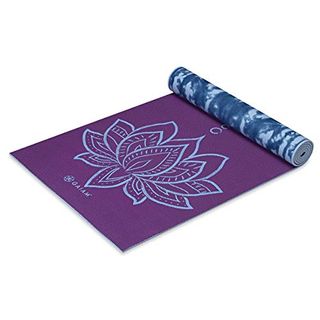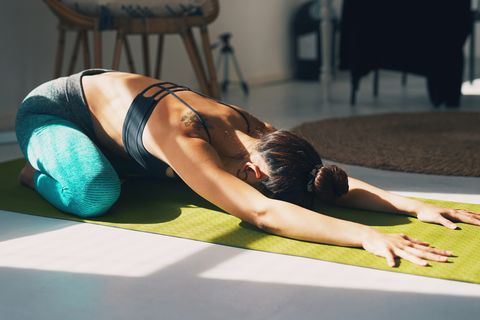8 Health Benefits of Doing Yoga Every Day
With so many different types of workouts out there, it can be a journey to find something that feels like a great fit for you—especially if you’re just getting started. But yoga, an ancient practice based on Indian philosophy that’s been around for centuries, combines mindfulness with physical movements to cultivate a balanced, healthy life.
“A consistent practice will lift the spirit, relax the mind, and strengthen and stretch the body among other benefits,” says Nicole Glor, fitness instructor and creator of NikkiFitness. “With yoga, you can quiet your mind and find joy by moving your body and controlling your breath.”
The benefits of yoga go way beyond being able to do a Downward Facing Dog—yoga is a lifestyle and complete program that helps you turn inward and find alignment of your mind and body. Not only can yoga help you lose weight, increase flexibility, and improve balance, but it can also help you reduce stress, feel happier, and sleep better.
There are so many wonderful reasons to cultivate a yoga practice, but it’s helpful to understand what yoga is and how to get started as a beginner before diving in. That way you can reap all of the physical, emotional, and spiritual benefits of this ancient practice—starting today.
What is yoga?
Although yoga is generally thought of as a way to move, this ancient Indian practice combines physical postures (asanas) with breath work (pranayama) and meditation (dyana) to help you achieve balance of your mind, body, and spirit. Established more than 4,000 years ago, yoga comes from the Sanskrit word “yuj” which means “union.” On a spiritual level, yoga refers to the union with a higher power and our true selves.
Using various asanas, pranayamas, and dyanas, yoga helps us evolve as people, embrace change and find calm. The physical asanas strengthen our muscles while helping to release tension of our bodies and minds. As a lifestyle, yoga cultivates in us a deep awareness of what’s working in our lives and what’s not so we can be our most authentic selves.
What to know about yoga as a beginner
Yoga is for absolutely everybody. Although social media may be saturated with yogis in headstands or advanced postures, yoga is accessible to every body type and level using modifications and proper anatomical cues.
“Many beginners are afraid to start because they ‘aren’t flexible enough’ or ‘don’t weigh their goal weight,’” Glor says. “These thoughts are what will become quieted when yoga helps to stretch their negative self talk into positive and to strengthen self acceptance while it stretches and strengthens their bodies.”
As a beginner, Glor recommends getting started with vinyasa, which means “to flow,” or Hatha yoga, where you hold poses for a bit longer. “Avoid power or hot yoga, which may be intense for those just getting started,” Glor says. She also suggests reading up on the history and cultural significance of yoga so you can understand the philosophy’s ancient roots. “Beginners should do some yoga reading while they also learn the poses and Sanskrit terms,” Glor says, suggesting The Heart of Yoga, Hatha Yoga Illustrated, Yoga Sutras of Patanjali, and Bhagavad Gita.
Ultimately, Glor says yoga is a great workout for someone just getting started with their workout routine because it’s low-impact, accessible to all ages and fitness levels, and boasts a wealth of benefits that strengthen the mind and body over time.
Benefits of yoga
Regardless if you’re a beginner or not, there are so many wonderful science-backed physical and emotional benefits of adding yoga to your daily routine. Read on for the best benefits of yoga, according to experts and research.
1. Yoga increases flexibility and stability.
According to the NIH, balance decreases overtime, but practicing yoga consistently can help you stay on your feet. “Being able to do a split and bind your arms behind your back might be the goal for some, but for others, functional movements like putting on socks in the morning without sitting down can make meaningful changes in your daily life,” Glor says. “This leads to keeping your body healthier as you age with less falls and injuries.”
2. Yoga strengthens your muscles and bones.
After the age of 30, we start to loose muscle mass, which can result in reduced mobility. “Practicing yoga can lead to stronger muscles,” Glor says. “When we do many Chaturangas (push-ups and planks) and Warriors with arms and quads shaking, we know we are building strength.” And research backs it. A study published in Topics in Geriatric Rehabilitation had around 200 women practice 12 yoga poses including Vrikasana (Tree Pose) and Virabhadrasana II (Warrior II) for 12 minutes a day over the course of two years and found that yoga may increase bone density.
3. Yoga improves posture.
“Posture is a great benefit of yoga in a world where many of us are bent over a desk writing, keyboard typing, and bending our necks down to look at an iPhone,” Glor says. Maintaining good posture can help reduce neck pain, increase energy levels, and improve digestion—and yoga can help you straighten out your spine. “Postures like Downward Facing Dog, Dolphin, Wheel, and Forearm Stand can strengthen overstretched muscles in the neck and shoulders to improve posture and elongate the spine,” Glor explains.
4. Yoga helps reduce chronic pain.
An estimated 50 million people suffer from chronic pain, the CDC says, but yoga has been found to provide relief. Not only does yoga improve flexibility and range of motion, but it also reduces inflammation, which may contribute to pain. A review published in Pain Research and Management found that a wide range of yoga poses reduces chronic back pain, even if only practiced for a short amount of time. Another study in Medicine showed that yoga might reduce neck pain and improve pain-related function related to disability.
5. Yoga might help you lose weight.
Research shows that a consistent yoga practice paired with an Ayurvedic diet—the ancient Indian holistic nutrition approach based on your body type—can result in weight loss. A small study published in Global Advances in Health and Medicine had overweight or obese adults follow an Ayurvedic diet paired with yoga therapy, and after nine months, participants lost an average of nine pounds.
6. Yoga reduces stress and anxiety.
There’s a reason ending your class with Savasana (Corpse Pose) helps you feel more calm—yoga combines many stress-reducing techniques, like mindfulness, exercise, and breathing to help you feel more zen. And research backs it up. A study published in Complementary Therapies in Clinical Practice showed that women who practiced prenatal Hatha yoga had reduced levels of cortisol (the stress hormone), increased resilience and pain tolerance, reduced anxiety, and improved mood. Certain yoga poses like Balasana (Child’s Pose) and Setu Bandhasana (Bridge Pose) help activate the parasympathetic nervous system, AKA our rest-and-digest response, to help us find calm.
7. Yoga improves sleep.
“In our fast-paced world, slowing down the breath with deep inhales and exhales while you link breath with movement can help you let go of anxiety, worry, and distractions,” Glor says. Racing thoughts are a huge culprit to keeping people up at night, but fortunately yoga can help you find calm before a night’s rest. A review published in the Journal of Ayurveda and Integrative Medicine found that yoga poses involving stretching and relaxing of the muscles, such as Restorative or Yin Yoga, causes physical and mental exertion that results in less sleep latency, more deep sleep, and fewer sleep disturbances.
8. Yoga reduces cognitive decline.
Keeping your mind sharp is vital to healthy aging, and while cognitive decline impacts many with age, yoga can help keep your mind strong. A study published by researchers at UCLA had 25 participants with memory problems practice either yoga or cognitive training for 12 weeks. Results showed that both groups showed improved memory and connections in the brain’s neuron networks.
This content is created and maintained by a third party, and imported onto this page to help users provide their email addresses. You may be able to find more information about this and similar content at piano.io











